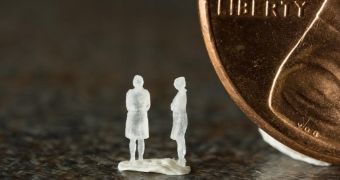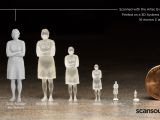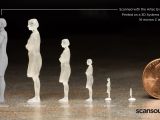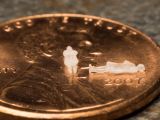One of the biggest limitations of FDM 3D printers is their resolution, the thickness level of each plastic layer as filament is melted and dropped through the extruder nozzle. There are other technologies that can enable a far higher detail, however, and a man by the name of Andrew Bougie has used it to give us a reason to feel a measure of admiration.
Normally, this would be our cue to talk about SLA 3D printing, stereolithography, or DLP, digital light processing (they're the same thing).
SLA works by bombarding resin with light and “curing” it, hardening it into the shape fed by a 3D model. SLA technology is what Andrew Bougie of ScanSource 3D employed. ScanSource 3D had its sights on 3D Systems ProJet 3500 HDMax, so that's what it used.
It works by laying down individual layers of a part, as well as its support material, through 618 jets contained in a single print head. The liquid resin is smoothed down using a roller, after which a UV flash bulb cures it.
Once parts are 3D printed in full, they are put into a low-temperature oven at 60-65° C / 140 – 149° F, to melt the wax-like support material.
The maximum resolution is supposed to be of 750 x 750 x 1600 DPI (XYZ), which corresponds to a layer thickness (Z-layer, height-wise as it were) of 16 microns.
16 microns is a lot better than the 100 mm afforded by FDM 3D printer (fused deposition modeling, used by most consumers). Indeed, it is a lot better than even the 50 mm afforded by the rare consumer FDM models.
The limits of the 3D Systems ProJet 3500 HDMax were pushed by Bougie's latest project, but the device raised to the occasion and successfully produced a 5mm-tall figurine of a human figure.
Bougie first used an Artec Eva scanner to build a 500,000-polygon model of his co-worker, which was overkill (the man himself admits it), but he wanted to make sure detail wasn't lacking. Then he scaled down the model to different sizes and made them all on the same build platform, all lying on their backs during the printing process.
Now, though, after around 9 hours of print time, they can stand on their feet just fine. The smallest is tiny compared to the coin next to it, at 5 mm height and 1.3 mm width. Some of the figures have jagged edges, but only because there is leftover wax support there, which the project overseers were too afraid to take off, since it risked breaking the prints themselves.

 14 DAY TRIAL //
14 DAY TRIAL // 


